
Leptodactylus is a genus of leptodactylid frogs. It includes the species commonly called ditch frogs or white-lipped frogs. It is very similar to Physalaemus, a close relative, and indeed the 2005 described Leptodactylus lauramiriamae is in some aspects intermediate between them.

Leptodactylus fragilis, known under many common names such as the Mexican white-lipped frog, American white-lipped frog or simply white-lipped frog, is a species of leptodactylid frog. Its distribution ranges from the Lower Rio Grande Valley of Texas in the United States south through Mexico and Central America to Colombia and Venezuela. It is often—wrongly—referred to as Leptodactylus labialis(Cope, 1878), which is a junior synonym of Leptodactylus mystacinus.

Phyllomedusa bicolor, the giant leaf frog, bicolor tree-frog, giant monkey frog, or waxy-monkey treefrog, is a species of leaf frog. It can be found in the Amazon basin of Brazil, Colombia (Amazonas), Bolivia, and Peru, and can also be found in the Guianan Region of Venezuela and the Guianas, and in Cerrado of the state of Maranhão in Brazil.
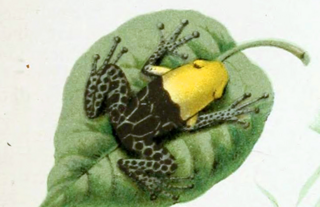
The red-headed poison frog, fantastic poison frog, or crowned poison frog is a species of frog in the family Dendrobatidae. It is endemic to Peru and found in the northern San Martín and Loreto Regions.
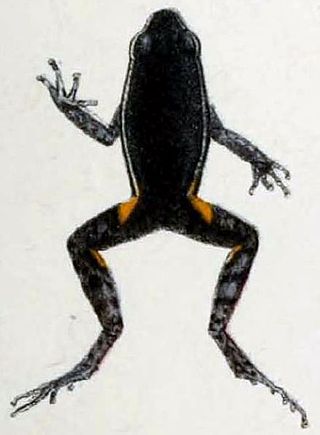
Ameerega hahneli is a species of frog in the family Dendrobatidae. It is found in the Amazonian lowlands of Brazil, Bolivia, Peru, Ecuador, Colombia, Venezuela, Guyana, French Guiana, and Suriname. It is named after Paul Hahnel, the collector of the type series.
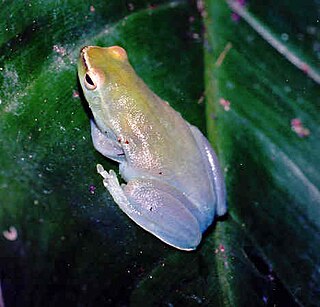
Sphaenorhynchus lacteus, the Orinoco lime treefrog or greater hatchet-faced treefrog, is a species of frog in the family Hylidae. It is a widely distributed species found in the Orinoco and Amazon basins in Venezuela, the Guianas, Colombia, Brazil, Ecuador, Peru, and Bolivia. It also occurs in Trinidad and Tobago.
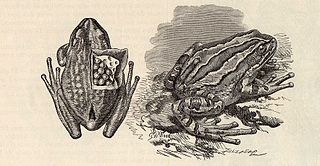
Gastrotheca marsupiata is a species of frog in the family Hemiphractidae. It is found in the Amazonian drainage systems of Andes from central Peru to southern Bolivia. Its common names are marsupian frog, common marsupial frog, and for now synonymized Leptodactylus/Eleutherodactylus andicola, Boettger's robber frog. It is a locally common frog present in primary, secondary and disturbed cloud and montane forests in the valleys of the central Andes.

Leptodactylus macrosternum is a species of frogs in the family Leptodactylidae. It is found in northern Argentina and adjacent eastern Bolivia, Paraguay, northern Uruguay, and southern and western Brazil. The specific name chaquensis refers to the area of Gran Chaco in Argentina. Common name Cei's white-lipped frog has been coined for it, although this particular species lacks the light upper lip stripe common in the genus.
Leptodactylus griseigularis is a species of frogs in the family Leptodactylidae. It is found in the Amazonian slopes of the Andes in Bolivia and Peru.

Leptodactylus knudseni, commonly called Knudsen's frog, is a species of frog in the family Leptodactylidae. Its local name is sapo-toro amazonico .

Leptodactylus leptodactyloides is a species of frogs in the family Leptodactylidae. Its local name is sapito leptodactilo. It is found in the greater Amazon Basin and the Guianas. Leptodactylus leptodactyloides occurs in a range of habitats: savannas, open areas, forest edges, and secondary and primary lowland forest. Reproduction takes place in temporary waterbodies.
Leptodactylus nesiotus is a species of frog in the family Leptodactylidae. It was originally described from Icacos Swamp on the south-western peninsula of Trinidad Island and was for a long time believed to be endemic to the island. However, in 2018 specimens were also reported from Guyana, Suriname, and French Guiana. It is probably the sister taxon of Leptodactylus validus. Indeed, the French Guianan records were first identified as L. validus, and it is possible that also some other L. validus records refer to Leptodactylus nesiotus. It is likely that this species is also found in Venezuela, perhaps even wider in open areas of northern South America.
Leptodactylus pascoensis is a species of frog in the family Leptodactylidae. It is endemic to Peru where it is only known from two localities ( ). It is an inhabitant of forest floor of the Amazonian flanks of the Andes. Reproduction takes place in foam nests in temporary ponds.
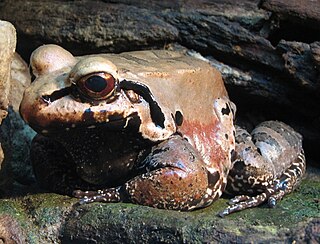
The smoky jungle frog is a species of frog in the family Leptodactylidae. It is found in Bolivia, Brazil, Colombia, Ecuador, Costa Rica, Panama, French Guiana, Perú and Venezuela. Its natural habitats are tropical and subtropical moist broadleaf forests, subtropical or tropical swamps, subtropical or tropical moist montane forest, rivers, freshwater marshes, intermittent freshwater marshes, and aquaculture ponds.
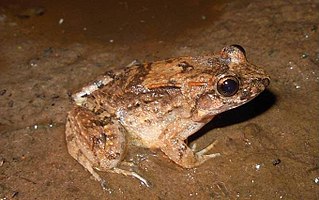
Leptodactylus petersii is a species of frog in the family Leptodactylidae. It is found widely in the Guianas and the Amazon Basin. It has been confused with Leptodactylus podicipinus and Leptodactylus wagneri, complicating the interpretation of older records and accounts.

Leptodactylus stenodema is a species of frog in the family Leptodactylidae. It is found in Brazil, Colombia, Ecuador, French Guiana, Guyana, Peru, Suriname, and possibly Bolivia.

The Windward ditch frog or smooth-skinned ditch frog is a species of frog in the family Leptodactylidae. It is found in the Lesser Antilles, the Guianas, and in the northernmost Brazil (Roraima) and in Venezuela. The Lesser Antillean part of the range might be due to human introduction. In 2018, the species was recorded from Colombia for the first time.

Leptodactylus wagneri is a species of frog in the family Leptodactylidae. It is found in northern South America.

Leptodactylus discodactylus is a species of frog in the family Leptodactylidae. It is found in the Amazonian Bolivia, Brazil, Peru, Ecuador, and Colombia.
Engystomops freibergi is a frog native to the Amazonian Brazil, southeastern Peru, and Amazonian Bolivia. For a while, it was considered to be a synonym of Engystomops petersi, its sibling species, but its species status was resurrected in a study published in 1998. Nevertheless, these two species have also been mixed in later studies, and there are records from the Guianas that have not yet been allocated to either species. Divergence of these two species seems to have been driven by behavioural isolation related to male call characteristics more than geographic isolation.


















